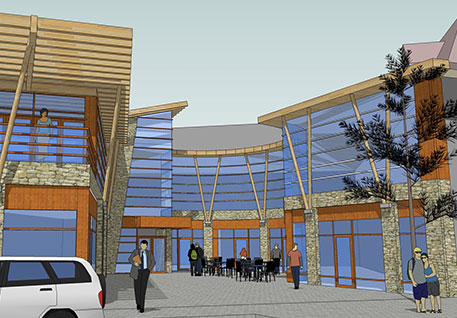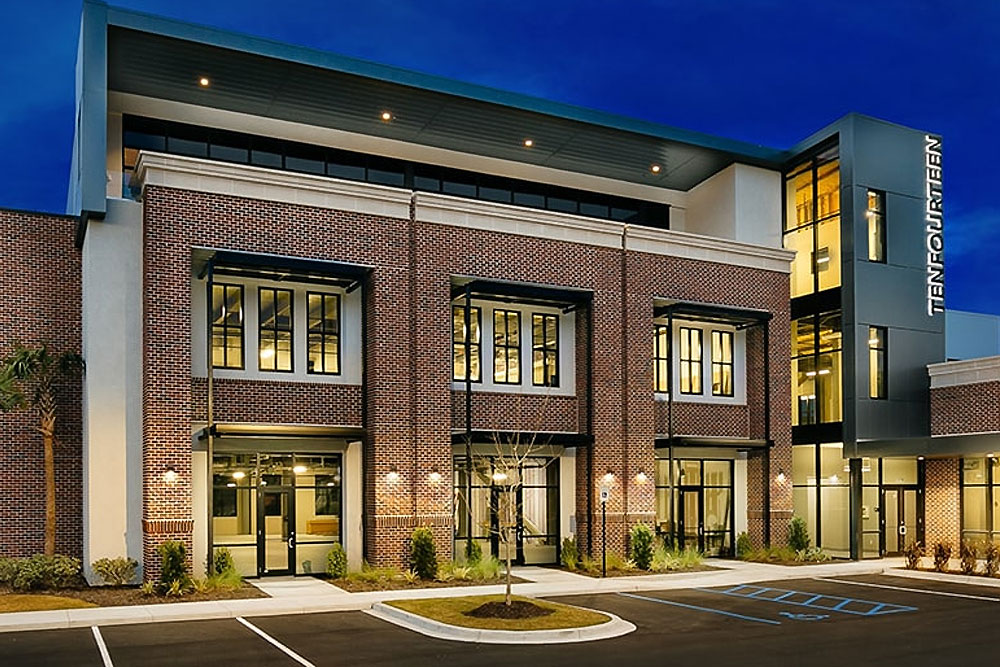How Commercial Architects Can Transform Your Company Area With Professional Style Solutions
Commercial architects play a necessary duty in reshaping business settings. Their expertise in design can significantly boost both functionality and appearances. By developing areas that show a brand's identity, they improve functional efficiency and staff member complete satisfaction. The effect of their job prolongs beyond plain appearance. Recognizing the subtleties of collaboration and sustainability can bring about transformative results. What details elements make these transformations successful?
Understanding the Duty of Commercial Architects
Commercial architects play an essential role in shaping organization settings that are both useful and aesthetically pleasing. They focus on developing rooms tailored to the specific demands of services, making sure that every square foot is utilized properly. These professionals integrate components such as spatial layout, lighting, and products to improve productivity and worker wellness. By teaming up with customers, business architects gather understandings into operational requirements and brand identity, equating these into cutting-edge designs.Additionally, they navigate intricate building regulations and zoning regulations, ensuring compliance while making the most of layout potential. Their experience encompasses sustainability methods, advertising power performance and eco-friendly products in their tasks. Through their creative vision and technical understanding, business architects not just produce attractive spaces but additionally foster settings that promote collaboration and development. Eventually, their contributions considerably affect the general success and picture of an organization.
Advantages of Professional Design Solutions

Tailoring Spaces to Your Brand Identity
Tailoring spaces to a brand name's identity is important for conveying its core values and objective. Commercial architects play a pivotal role in improving a service's aesthetic identification through thoughtful layout options. By lining up architectural aspects with brand principles, companies can create environments that resonate with customers and workers alike.
Mirroring Brand Worths
How can a properly designed room embody a firm's core values? Commercial architects play an essential function fit atmospheres that reverberate with a brand's identification. By incorporating elements such as color pattern, products, and layouts, they create rooms that show the essence of the company. A tech business may opt for open formats and modern-day home furnishings to communicate development and cooperation, while a high-end brand name may choose stylish finishes and intimate rooms to evoke exclusivity and refinement. Thoughtful design not just boosts functionality however also promotes a strong link between staff members, clients, and the brand. Ultimately, a well-crafted atmosphere works as a tangible depiction of a firm's objective and vision, enhancing its values at every touchpoint.
Enhancing Aesthetic Identification
What aspects can properly elevate a brand name's aesthetic identity within an industrial space? Commercial architects play a pivotal function in incorporating design features that resonate with a business's principles. Color schemes, typography, and materials can be strategically chosen to show brand name worths while making sure visual appeal. Additionally, incorporating logos and brand name images right into the architecture can create a cohesive aesthetic narrative. Illumination layout can further enhance the environment, leading consumer understandings and experiences (commercial architects). Layout and furnishings choices should align with the brand's personality, whether it's modern-day, typical, or innovative. Ultimately, a well-designed commercial area not just draws in clients however additionally reinforces brand name acknowledgment, creating a long lasting perception that promotes loyalty and engagement
Enhancing Functionality and Efficiency
Enhancing functionality and efficiency in commercial areas entails maximizing room application and creating process that enhance operations. Architects concentrate on creating formats that lessen wasted space while Bonuses helping with smooth changes between jobs. This strategy not just improves productivity yet likewise adds to an extra cohesive functioning setting.
Enhancing Area Use
Effective room use is a critical variable in industrial architecture, where the design must stabilize looks with functionality (commercial architects). Architects use various approaches to optimize available square video footage while ensuring that each location offers a distinct function. By analyzing process, website traffic patterns, and user requirements, architects can develop designs that boost both employee performance and client experience. Multi-functional areas, flexible furniture setups, and enhanced storage space services are important parts in achieving this goal. In addition, incorporating natural light and open areas cultivates a much more welcoming ambience, further boosting the energy of the setting. Eventually, effective space use not just enhances functional efficiency yet also contributes positively to the total brand name image, making it an essential consideration in business layout
Streamlined Workflow Style
Exactly how can a properly designed operations change an industrial space right into a hub of productivity? Structured process design concentrates on enhancing the physical design and functional procedures within a business environment. By tactically setting up workstations, meeting areas, and sources, architects can remove unneeded movement and boost partnership. This thoughtful style lessens disturbances and helps with communication, allowing employees to concentrate on their jobs extra successfully. Furthermore, incorporating modern technology right into the operations can additionally automate processes, lowering time spent on routine jobs. As an outcome, companies experience improved staff member Click Here morale and raised result, developing a dynamic atmosphere that fosters technology. Eventually, buying streamlined operations style not only enhances capability however likewise places a business area for sustainable development and success.
Promoting Collaboration Via Design
Although modern-day offices typically focus on private performance, the style of commercial areas increasingly highlights collaboration as a crucial driver of technology and group cohesion. Architects play an essential role in producing environments that promote communication among workers. Open up layouts, multifunctional areas, and strategically put public areas urge spontaneous conversations and brainstorming sessions.Incorporating aspects such as movable furnishings and adaptable conference room enables groups to reconfigure rooms based upon their collaborative requirements. Furthermore, incorporating technology, like interactive whiteboards and video conferencing tools, enhances the capability to connect efficiently, despite location.Natural light and biophilic layout components also add to a much more inviting environment, advertising convenience and health, which are important for efficient team effort. By concentrating on these facets, business architects can develop dynamic atmospheres that not only boost collaboration however additionally drive overall service success.
Sustainable Style Practices in Commercial Architecture

Case Studies: Successful Improvements by Commercial Architects
The execution of lasting design practices has not only improved the approach to industrial design yet has actually additionally brought about remarkable transformations in various company areas. One significant instance is the redesign of a technology business's head office, where architects incorporated all-natural light and eco-friendly wall surfaces, causing improved worker well-being and productivity. This makeover lowered power prices by 30% and boosted the firm's public image.In an additional circumstances, a store went through a total overhaul, making use of recovered materials and energy-efficient systems. This not just go to website brought in eco-conscious consumers however also boosted foot web traffic by 25%. A third case involved a corporate workplace that accepted an open-plan design with flexible work areas, fostering cooperation amongst groups. The architects' emphasis on producing a dynamic and adaptable setting substantially improved employee fulfillment. These case research studies exemplify exactly how business architects can produce impactful spaces that straighten with company objectives and sustainability efforts.
Frequently Asked Questions
Just How Much Do Commercial Design Provider Generally Cost?
The price of commercial style services differs commonly, typically varying from $100 to $250 per hour. Elements affecting pricing consist of task complexity, area, and the designer's experience, making it essential for services to get comprehensive price quotes.
What Sorts Of Organizations Profit Many From Commercial Architects?
Numerous companies, consisting of retail, friendliness, and business workplaces, considerably gain from industrial architects. These experts enhance performance, visual appeals, and brand name identification, ensuring areas are maximized for customer interaction and worker performance, ultimately promoting service development.
The length of time Does a Business Layout Project Usually Take?
The timeline for an industrial style task typically ranges from a number of weeks to a number of months. Variables affecting duration include task intricacy, governing approvals, and collaboration among stakeholders, all of which can affect general conclusion time.
Can I Employ a Commercial Engineer for Restorations Only?
Yes, working with a business engineer for restorations is feasible. Many architects specialize in restoration jobs, offering experience in optimizing existing rooms while adhering to guidelines and improving performance, appearances, and total worth of the service atmosphere.
What Certifications Should I Search for in an Industrial Architect?
